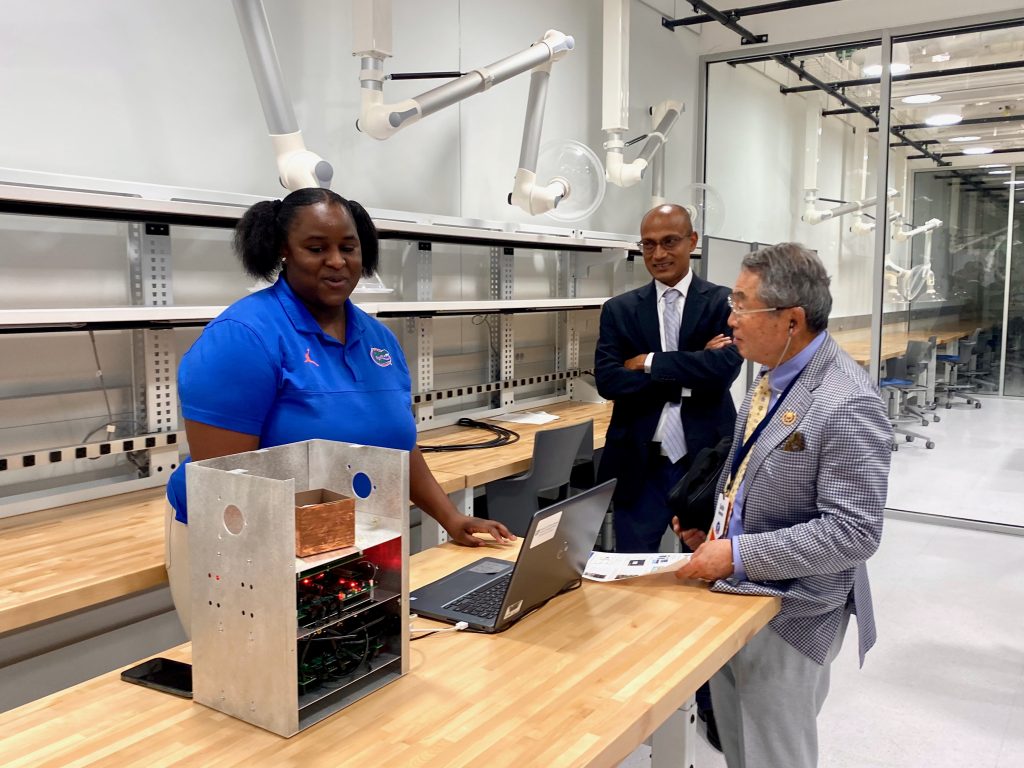On November 3, 2023, the University of Florida held a ribbon cutting ceremony to celebrate the opening of the Malachowsky Hall for Data Science & Information Technology. Malachowsky Hall will serve as a multidisciplinary space for medicine, pharmacy and engineering, and will further support UF’s work to integrate AI across the curriculum. As the new headquarters of the Warren B. Nelms Institute for the Connected World, institute students were invited to demonstrate their research projects at the event for university leaders, alumni, and esteemed guests.
Six exciting Internet of Things (IoT) projects from the Warren B. Nelms Institute for the Connected World were showcased by undergraduate and graduate students in the institute. Read more about the projects below.
Non-invasive Authentication of Mail Packaging Using Nuclear Quadrupole Resonance Spectroscopy
Presented By: Kelsey Horace-Herron
NQR is a highly sensitive authentication device that utilizes Nuclear Quadrupole Resonance (NQR) technology to detect illegal substances. It is a portable benchtop form factor device that is designed for professional personnel such as postal service, federal and state law enforcement agencies, mail order pharmacies, and analytical laboratories. iNQR is a patented instrument that replaces the commercial spectrometer with a low-cost and miniaturized custom NQR spectrometer.



Demonstration on Selectivity in Human Body Communication for IoT and IoB Applications
Presented By: Ovishake Sen, Anyu Jiang
We demonstrate the selectivity of human body communication (HBC) as a low-power communication modality for Internet of Things (IoT) and Internet of Bodies (IoB) applications. The advantages of HBC over traditional communication techniques (such as Bluetooth) are:
- The Human Body Channel has lower loss due to the conductive properties of the body, which results in less power consumption (~100X better)
- HBC ensures better security and selectivity as compared to Bluetooth (~30X better)

Puppet System – Improving Children’s Story Writing Through Digital Enactment
Presented By: Nanjie (Jimmy) Rao


The Puppet System alleviates the complexity of story writing for children by separating the creative expression of ideas from the linguistic technicalities, utilizing digital enactment as a solution.
Initially employing full body motion tracking with Real-time cartoon output for Digital Enactment, aiding in the creation of richer written stories. The Puppet System’s hybrid tracking, integrating vision and sensor technology, is more portable and easier to setup compared to the previous full body motion capture system.

SAFER – Smart Adjustable Feet Activity tRacking system
Presented By: Reiner Dizon-Paradis
SAFER is a Smart Adjustable FEet activity tRacking system. It allows patients and health care providers to monitor the amount of pressure being placed on certain areas of the foot. The monitoring system would be in the sole that can be inserted on a shoe with Force sensors.
Force sensing PCB has a long arm that holds the force sensor which sits on top of the insole, while the remaining part of the circuit sit along the side walls of the sole. The power unit and central processor is made of FR-4 material but can sit on the ankle with adhesive.

AI & Hardware Adventure Board (AHA Board)
Presented By: Mary Slowik, Devin Thompson, Jellane Fauni, Jack Rainville, Andrea Ramirez Salgado, Rohan Reddy Kalavakonda
This demo shows two AI based applications running on the AI & Hardware Adventure (AHA) Board. We will be using the AHA Board to detect movement patterns using a machine learning model running locally on the AHA Board. Another application that is included in the demo involves using the AHA Board to control devices by linking it with Voice Assistants such as Google Assistant, Siri, Alexa etc.


FoveaCam: Fast Foveating Cameras
Presented By: Brevin Tilmon and Yuxuan Zhang

 FoveaCam uses computer vision and high-speed optics to turn an off the shelf camera into multiple foveating cameras, enabling extremely high-resolution video-rate imaging of multiple regions of interest at once.
FoveaCam uses computer vision and high-speed optics to turn an off the shelf camera into multiple foveating cameras, enabling extremely high-resolution video-rate imaging of multiple regions of interest at once.
FoveaCam overcomes conventional optics constraints in cameras that typically sacrifice field of view for resolution.






